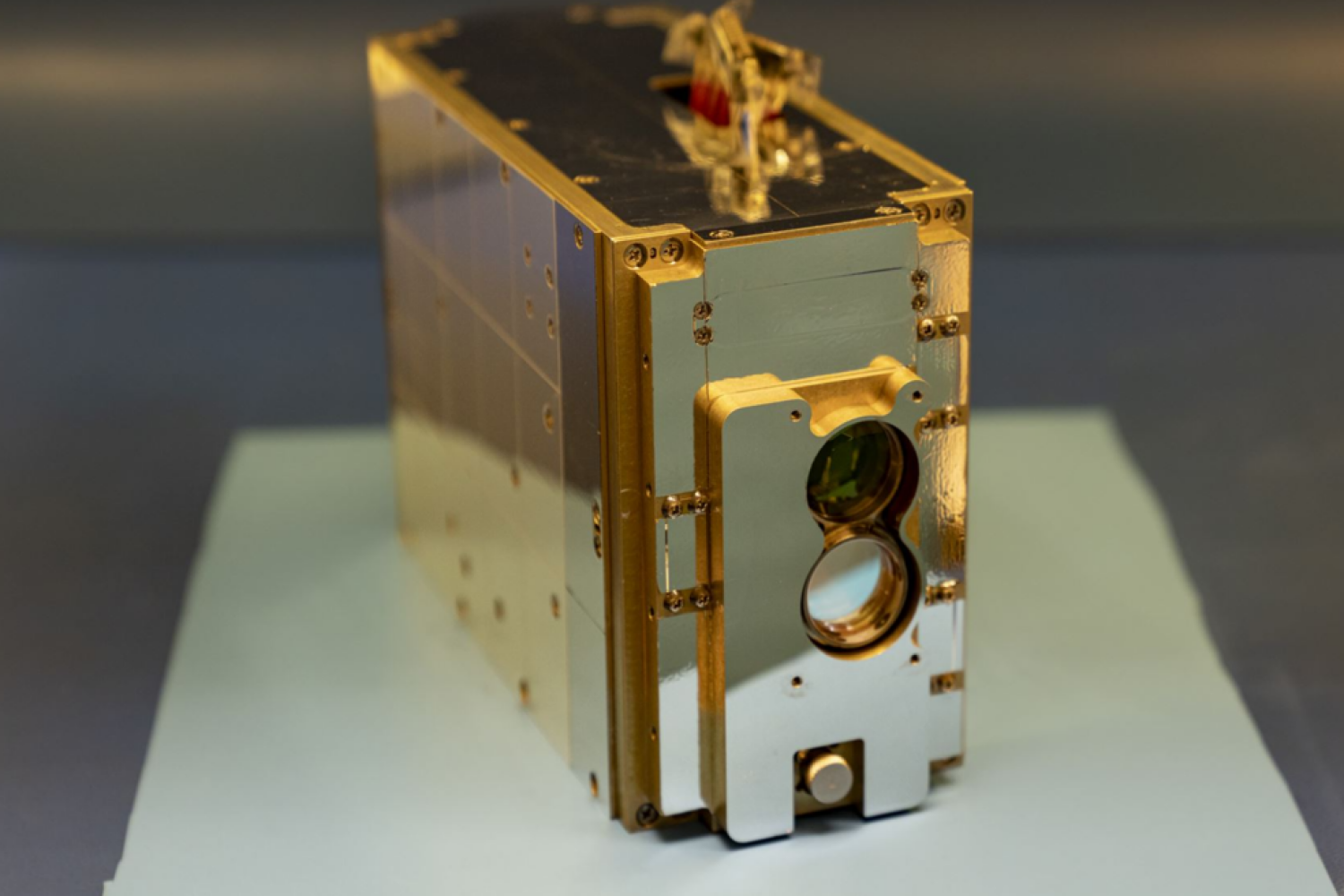100 Gbps achieved from space to Earth, fastest laser link record set by MIT/NASA
In May 2022, the TBIRD (TeraByte InfraRed Delivery) payload aboard a small CubeSat satellite was launched into orbit 300 miles above the Earth's surface. Since then, TBIRD has delivered terabytes of data at record rates of up to 100 gigabits per second - 100 times faster than the fastest internet speeds in most cities - via an optical communications link to a receiver at the soil in California. This throughput is more than 1,000 times higher than that of radio frequency links traditionally used for satellite communications and the highest ever achieved by a laser link from space to the ground. And those record-breaking speeds were all made possible by a communications payload roughly the size of a tissue box.
MIT's Lincoln Laboratory conceptualized the TBIRD mission in 2014 as a way to provide unprecedented capability for low-cost science missions. Today, scientific instruments in space routinely generate more data than can be sent back to Earth via typical space-to-ground communication links. With small, low-cost space and ground terminals, TBIRD can enable scientists around the world to take full advantage of laser communications to transmit all the data they could ever dream of.
Designed and built at Lincoln Laboratory, the TBIRD communications payload was integrated into a CubeSat manufactured by Terran Orbital as part of NASA's Pathfinder Technology Demonstrator program. NASA's Ames Research Center established this program to develop a CubeSat bus (the "vehicle" that powers and directs the payload) to get science and technology demonstrators into orbit faster and more cheaply. Weighing about 25 pounds and the size of two stacked cereal boxes, the CubeSat was launched into low Earth orbit (LEO) aboard Space X's Transporter-5 rideshare mission from Cape Canaveral Space Force Station. in Florida in May 2022. The optical ground station is located in Table Mountain, California, where most weather occurs below the mountain peak, making this part of the sky relatively clear for laser communication. This ground station operates the one-meter telescope and adaptive optics (to correct for distortions caused by atmospheric turbulence) of NASA's Jet Propulsion Laboratory Optical Communications Telescope Laboratory, with Lincoln Laboratory providing the communications hardware floor specific to TBIRD.
"We have demonstrated higher data throughput than ever before in a smaller package than ever before," says Jade Wang, lab program manager for TBIRD payload and ground communications and deputy group leader of optical and quantum communications technology. . “While sending data from space using lasers may seem futuristic, the same technical concept is behind the fiber optic internet that we use every day. The difference is that laser transmissions have place in the open atmosphere, rather than in confined fibers."
From radio waves to laser light
Whether it's video conferencing, gaming, or streaming movies in high definition, you're using high-speed links that pass through glass (or sometimes plastic) optical fibers. About the diameter of a strand of human hair, these fibers are bundled into cables, which transmit data via fast-moving pulses of light from a laser or other source. Fiber optic communications are paramount in the age of the Internet, in which large amounts of data must be distributed quickly and reliably across the globe every day.
For satellites, however, a high-speed Internet based on laser communications does not yet exist. Since the beginning of spaceflight in the 1950s, missions have relied on radio frequencies to send data to and from space. Compared to radio waves, infrared light used in laser communications has a much higher frequency (or shorter wavelength), allowing more data to be packed into each transmission. Laser communications will allow scientists to send 100 to 1,000 times more data than current radio frequency systems, akin to our terrestrial shift from dial-up to high-speed Internet.
From Earth observation to space exploration, many science missions will benefit from this acceleration, especially as instrument capabilities advance to capture the greater amounts of high-resolution data that experiments entail. more remote control and for spacecraft to travel farther from Earth into deep space.
However, laser space communication comes with several technical challenges. Unlike radio waves, laser light forms a narrow beam. For successful data transmission, this narrow beam must be pointed precisely at a receiver (e.g., telescope) located on the ...

In May 2022, the TBIRD (TeraByte InfraRed Delivery) payload aboard a small CubeSat satellite was launched into orbit 300 miles above the Earth's surface. Since then, TBIRD has delivered terabytes of data at record rates of up to 100 gigabits per second - 100 times faster than the fastest internet speeds in most cities - via an optical communications link to a receiver at the soil in California. This throughput is more than 1,000 times higher than that of radio frequency links traditionally used for satellite communications and the highest ever achieved by a laser link from space to the ground. And those record-breaking speeds were all made possible by a communications payload roughly the size of a tissue box.
MIT's Lincoln Laboratory conceptualized the TBIRD mission in 2014 as a way to provide unprecedented capability for low-cost science missions. Today, scientific instruments in space routinely generate more data than can be sent back to Earth via typical space-to-ground communication links. With small, low-cost space and ground terminals, TBIRD can enable scientists around the world to take full advantage of laser communications to transmit all the data they could ever dream of.
Designed and built at Lincoln Laboratory, the TBIRD communications payload was integrated into a CubeSat manufactured by Terran Orbital as part of NASA's Pathfinder Technology Demonstrator program. NASA's Ames Research Center established this program to develop a CubeSat bus (the "vehicle" that powers and directs the payload) to get science and technology demonstrators into orbit faster and more cheaply. Weighing about 25 pounds and the size of two stacked cereal boxes, the CubeSat was launched into low Earth orbit (LEO) aboard Space X's Transporter-5 rideshare mission from Cape Canaveral Space Force Station. in Florida in May 2022. The optical ground station is located in Table Mountain, California, where most weather occurs below the mountain peak, making this part of the sky relatively clear for laser communication. This ground station operates the one-meter telescope and adaptive optics (to correct for distortions caused by atmospheric turbulence) of NASA's Jet Propulsion Laboratory Optical Communications Telescope Laboratory, with Lincoln Laboratory providing the communications hardware floor specific to TBIRD.
"We have demonstrated higher data throughput than ever before in a smaller package than ever before," says Jade Wang, lab program manager for TBIRD payload and ground communications and deputy group leader of optical and quantum communications technology. . “While sending data from space using lasers may seem futuristic, the same technical concept is behind the fiber optic internet that we use every day. The difference is that laser transmissions have place in the open atmosphere, rather than in confined fibers."
From radio waves to laser light
Whether it's video conferencing, gaming, or streaming movies in high definition, you're using high-speed links that pass through glass (or sometimes plastic) optical fibers. About the diameter of a strand of human hair, these fibers are bundled into cables, which transmit data via fast-moving pulses of light from a laser or other source. Fiber optic communications are paramount in the age of the Internet, in which large amounts of data must be distributed quickly and reliably across the globe every day.
For satellites, however, a high-speed Internet based on laser communications does not yet exist. Since the beginning of spaceflight in the 1950s, missions have relied on radio frequencies to send data to and from space. Compared to radio waves, infrared light used in laser communications has a much higher frequency (or shorter wavelength), allowing more data to be packed into each transmission. Laser communications will allow scientists to send 100 to 1,000 times more data than current radio frequency systems, akin to our terrestrial shift from dial-up to high-speed Internet.
From Earth observation to space exploration, many science missions will benefit from this acceleration, especially as instrument capabilities advance to capture the greater amounts of high-resolution data that experiments entail. more remote control and for spacecraft to travel farther from Earth into deep space.
However, laser space communication comes with several technical challenges. Unlike radio waves, laser light forms a narrow beam. For successful data transmission, this narrow beam must be pointed precisely at a receiver (e.g., telescope) located on the ...
What's Your Reaction?















![Three of ID's top PR executives quit ad firm Powerhouse [EXCLUSIVE]](https://variety.com/wp-content/uploads/2023/02/ID-PR-Logo.jpg?#)







